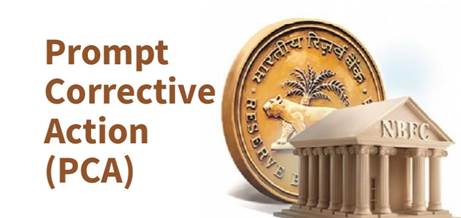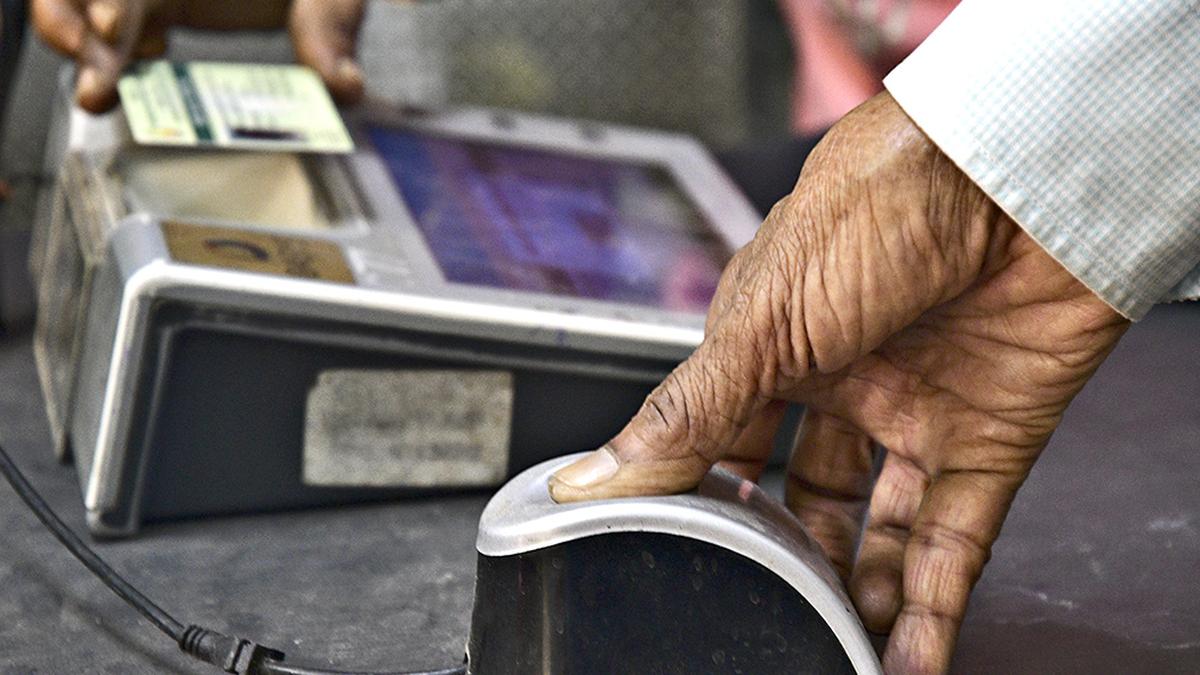Description

Disclaimer: Copyright infringement not intended.
Context
- The Reserve Bank of India (RBI) on Tuesday removed Central Bank of India from its Prompt Corrective Action Framework (PCAF) after the lender showed improvement in various financial ratios, including minimum regulatory capital and net non-performing assets (NNPAs).
PCA
- Prompt Corrective Action (PCA) is a system that the RBI imposes on banks showing signs of financial stress. The regulator considers banks as unsafe if they fail to meet the standards on certain financial metrics or parameters.
- Reserve Bank of India had introduced a Prompt Corrective Action Framework (PCA) for Scheduled Commercial Banks in 2002.
- The PCA Framework for NBFCs, came into effect from October 1, 2022. This is to further strengthen the supervisory tools applicable to NBFCs.
Read all about NBFCs: https://www.iasgyan.in/blogs/nbfcs-and-its-types
When Does RBI Invoke Prompt Corrective Action?
- RBI takes into account four factors to determine whether it needs to put a bank under the PCA framework. These include profitability, asset quality, capital ratios and debt level.
- The central bank grades each of these factors based on actions depending upon the grade/threshold level, categorized from one to three, where 1 is the lowest of the lot and 3 being the highest based on how banks stand with respective frameworks.
Following is a look at these factors and their grades:
Capital Adequacy Ratio (CRAR)
- The CRAR is basically the capital needed for a bank measured in terms of assets (mostly loans) disbursed by the banks.
- The higher the assets, the higher should be the capital retained by the bank.
- This measures how much debt and equity capital banks possess to cover their asset book risk.
- If CRAR is less than 10.25%, but above 7.75%, the bank falls in the first grade.
- Banks having a CRAR of over 6.25%, but below 7.75%, fall under grade 2. However, if a bank's capital adequacy ratio is less than 3.625%, it is categorised under grade 3.
|
Capital Adequacy Ratio (CAR)
Capital Adequacy Ratio (CAR) is the ratio of a bank’s capital in relation to its risk weighted assets and current liabilities. It is decided by central banks and bank regulators to prevent commercial banks from taking excess leverage and becoming insolvent in the process.
Description: It is measured as
Capital Adequacy Ratio = (Tier I + Tier II + Tier III (Capital funds)) /Risk weighted assets
The risk weighted assets take into account credit risk, market risk and operational risk.
The Basel III norms stipulated a capital to risk weighted assets of 8%. However, as per RBI norms, Indian scheduled commercial banks are required to maintain a CAR of 9% while Indian public sector banks are emphasized to maintain a CAR of 12%.
|
Asset Quality
- This parameter refers to the non-performing assets of a bank. If the net NPA of a bank is more than 6%, but less than 9%, it falls under the first threshold.
- If Net NPA crosses the 9% mark, it triggers the second grade. That said, if this metric is 12% or more, the bank will fall in the third grade of PCA.
Read all about NPAs: https://www.iasgyan.in/daily-current-affairs/non-performing-assets
Profitability
- The regulator considers the return on assets (ROA) of a bank as the key measure for profitability. Note that if a bank's ROA is negative for two, three and four years in a row, it will be categorised as grade 1, grade 2 and grade 3, respectively.
Debt Level/Leverage
- The last factor that RBI considers to measure the financial risk of any bank is its overall debt level/leverage.
- The regulator triggers grade 1 if the overall leverage of a bank is more than 25 times its Tier 1 capital.
- However, when total leverage is over 28.5 times its core capital (including disclosed reserves), RBI takes action according to grade 2 of PCA.

Corrective Actions that can be taken when a Bank is put under PCA framework
- Special Supervisory Actions
- Special Supervisory Monitoring Meetings (SSMMs) at quarterly or other identified frequency
- Special inspections/targeted scrutiny
- Restricted and need based regulatory/supervisory approvals to be given by the Reserve Bank
- Resolution by Amalgamation/ Reconstruction/ Splitting
- File insolvency application under IBC (under Insolvency and Bankruptcy Code, 2016 )
- Winding up of the NBFC
- Strategy related Actions
- Activate the Recovery Plan that has been duly approved by the Supervisor
- Undertake a detailed review of business model in terms of sustainability of the business model, profitability of business lines and activities, medium and long term viability, etc.
- Review short-term strategy focusing on addressing immediate concerns
- Review medium-term business plans, identify achievable targets and set concrete milestones for progress and achievement
- Undertake business process reengineering as appropriate
- Undertake restructuring of operations as appropriate
- Governance related Actions
- RBI may actively engage with the NBFC’s Board on various aspects as considered appropriate
- RBI may recommend to promoters/shareholders to bring in new Management/ Board
- RBI may remove managerial persons under the RBI Act, as applicable
- Removal of Director and/or appointment of another person as Director in his place
- RBI may supersede the Board under the RBI Act and appoint an Administrator
- RBI may require the NBFC to invoke claw back and malus clauses and other actions as available in regulatory guidelines, and impose other restrictions or conditions
- Impose restrictions on Directors’ or Management compensation, as applicable.
- Capital related Actions
- Detailed Board level review of capital planning
- Submission of plans and proposals for raising additional capital
- Requiring the NBFC to bolster reserves through retained profits
- Restriction on investment in subsidiaries/associates
- Restriction in expansion of high risk-weighted assets to conserve capital
- Reduction in exposure to high-risk sectors to conserve capital
- Restrictions on increasing stake in subsidiaries and other group companies
- Credit risk related Actions
- Preparation of time bound plan and commitment for reduction of stock of NPAs
- Preparation of and commitment to plan for containing generation of fresh NPAs
- Strengthening of loan review mechanism
- Restrictions/reduction in total credit risk weight density (example: restriction/ reduction in credit for borrowers below certain rating grades, restriction/reduction in unsecured exposures, etc.)
- Reduction in loan concentrations in identified sectors, industries or borrowers
- Sale of assets
- Action plan for recovery of assets through identification of areas (geography-wise, industry segment-wise, borrower-wise, etc.) and setting up of dedicated Recovery Task Forces, etc.
- Prohibition on expansion of credit/ investment portfolios other than investment in government securities / other High-Quality Liquid Investments
- Higher provisioning for NPAs/NPIs
- Market risk related Actions
- Restrictions on/reduction in borrowings from the debt market
- Restrictions on accepting/ renewing deposits and escrowing of cash inflows to meet deposit liabilities to protect the interest of the depositors
- Restrictions on investment activities
- HR related Actions
- Restriction on staff expansion/staff compensation
- Review of specialized training needs of existing staff
- Profitability related Actions
- Restrictions on capital expenditure, other than for technological upgradation within Board approved limits
- Restrictions/reduction in variable operating costs
- Operations related Actions
- Restrictions on branch expansion plans; domestic or overseas
- Reduction in business at subsidiaries/ in other entities
- Restrictions on entering into new lines of business
- Reduction in leverage
- Reduction in risky assets
- Restrictions in undertaking businesses, as may be specified
- Restriction/reduction of outsourcing activities
- Restrictions on new borrowings
Which NBFCs fall under the purview of PCA Framework introduced by RBI?
The RBI came up with a PCA Framework and included the following entities within its purview:
- All the NBFC’s taking deposits (NBFCs-D) but excludes the government companies
- All the Non-Deposit taking NBFC’s (NBFCs-ND) in Middle, Upper and Top layers but exclude the:
- NBFC’s which do not accept or do not intend to accept public funds.
- Housing finance companies
- Government companies
- Primary Dealers.
However, following are the entities that are included within the scope of NBFCs-ND:
- Core Investment Companies (CICs)
- Infrastructure Finance Companies
- Investment and Credit companies
- Micro Finance Institutions and Factors
- Infrastructure Debt Funds
- PCA Framework monitors the NBFCs in the following areas
- NBFCs-D and NBFCs-ND are monitored in the areas of Asset Quality and Capital
- CICs are monitored in the areas of Asset Quality, Capital and Leverage.
PCA Framework tracks the following indicators of NBFCs
- For NBFCs-D and NBFCs-ND the framework will track indicators like Capital to Risk (Weighted) Assets Ratio (CRAR), Net NPA Ration (NNPA), Tier-1 Capital Ratio.
- For CICs, the indicators are NNPA, Adjusted Net Worth/Aggregate Risk Weighted Assets and Leverage Ratio.
|
What is CRAR?
Capital to Risk (Weighted) Assets Ratio (CRAR) also called as Capital Adequacy Ratio which is a representation of the ratio of the bank’s capital to the associated risk weighted assets such as market risk, credit risks etc. A high CRAR represents the entity is highly capitalised. Higher the CRAR, higher the lender is capitalized.
What is Tier 1 Capital Ratio?
Tier 1 Capital Ratio represents the bank’s core Tier 1 capital i.e. the ratio of the bank’s equity reserves plus disclosed reserves to the total risk weighted assets.
What is NNPA ratio?
NNPA stands for Net Non-Performing Assets, which is the ratio of non-performing assets to the total loans given.
What is Adjusted Net Worth (ANW)?
Adjusted Net Worth refers to the estimated value of the business as per the company’s accounts books after adding unrealized capital gains, voluntary reserves and capital surplus.
What are Aggregate Risk Weighted Assets (RWA)?
It refers to the least amount of capital that is held by the banks in order to avoid the situation of insolvency.
|
Importance of PCA
- It is crucial that RBI undertakes the remedial measures on time, or else banking institutions may not have sufficient capital to cover the losses. These losses tend to happen due to multiple factors both internal (due to the borrowers) such as when companies or institutions are unable to meet their loan obligations and external factors where the overall economy slows down as a result of which borrowers are unable to meet loan obligations.
- While some banks have the capacity to withstand challenging phases of operations, others not so much. This is where RBI steps in through the PCA framework, essentially providing an opportunity for the banks to clean their operations. It can benefit both banks and depositors of the banks.
https://indianexpress.com/article/business/banking-and-finance/rbi-removes-central-bank-of-india-from-prompt-corrective-action-framework-8163142/
Array
(
[0] => daily-current-affairs/prompt-corrective-action-framework
[1] => prompt-corrective-action-framework
)








